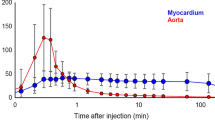Abstract.
Dysfunction of the sympathetic nervous system underlies a number of myocardial disorders. Positron emission tomography (PET) offers a way of assessing receptor function non-invasively in humans, but there are no PET radioligands for assessing myocardial α-adrenoceptors. GB67, a structural and pharmacological analogue of the α1-adrenoceptor antagonist prazosin, was labelled with positron-emitting carbon-11 (t 1/2=20.4 min) by 11C-methylation of N-desmethylamido-GB67 (GB99). [11C]GB67 was injected intravenously into conscious rats. Serial arterial blood samples were taken. Rats were killed and tissues removed to determine radioactivity. The percentages of unchanged [11C]GB67 and its radioactive metabolites in plasma and tissues were assessed by HPLC. Plasma clearance of radioactivity was rapid. Myocardial uptake was maximal at 1–2 min and decreased slowly during 60 min. Predosing with adrenoceptor antagonists demonstrated selectivity for myocardial α1-adrenoceptors. GB67 and prazosin blocked uptake of radioactivity; the non-selective antagonist, phentolamine, partially blocked uptake; the α2-adrenoceptor antagonist, RX 821002, only blocked uptake at high dose and the β-adrenoceptor antagonist, CGP 12177, had no effect. Additionally, injection of prazosin at 20 min after radioligand displaced radioactivity. In vivo competition curves obtained by injecting [11C]GB67 with varying amounts of either unlabelled GB67 or its precursor GB99 were fitted to a competitive binding model to provide estimates of the maximum number of binding sites (B max) and half saturation doses (K) for myocardium. Assuming a tissue protein content of 10%, the values of B max [∼13 pmol·(g tissue)–1] were similar to those [50–170 fmol·(mg protein)–1] reported for myocardial α1-adrenoceptors assessed in vitro. Both GB67 and its precursor GB99 had high affinity for α1-adrenoceptors [K GB67=1.5 nmol·(kg body weight)–1, K GB99=4.8 nmol· (kg body weight)–1]. HPLC demonstrated four radioactive metabolites in plasma. [11C]GB67 was 80% of the radioactivity at 5 min and 50% at 45 min. No radioactive metabolites were detected in myocardium up to 60 min after injection. [11C]GB67 was assessed in two male human volunteers. PET demonstrated high myocardial uptake. The profile of radioactive metabolites in plasma was comparable to that in the rat, although metabolism was slower in humans. Thus, [11C]GB67 is a promising radioligand for assessing α1-adrenoceptors in human myocardium with PET.
Similar content being viewed by others
Author information
Authors and Affiliations
Additional information
Received 7 May and in revised form 9 August 1999
Rights and permissions
About this article
Cite this article
Law, M., Osman, S., Pike, V. et al. Evaluation of [11C]GB67, a novel radioligand for imaging myocardial α1-adrenoceptors with positron emission tomography. Eur J Nucl Med 27, 7–17 (2000). https://doi.org/10.1007/PL00006665
Issue Date:
DOI: https://doi.org/10.1007/PL00006665



